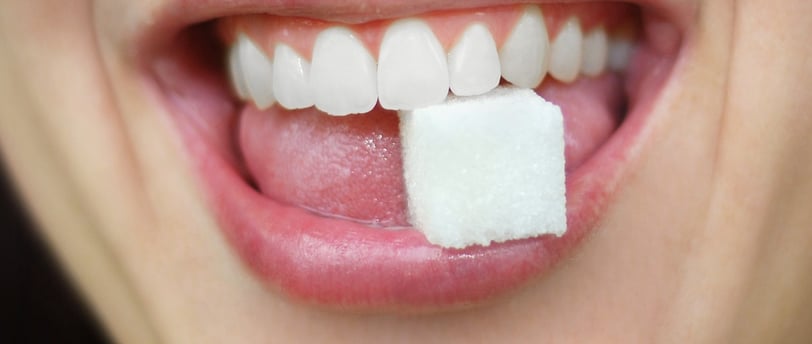Protecting Your Teeth from Sugar Damage
SMILE PROTECTION TIPS
11/11/20244 min read


Understanding Sugar and Its Impact on Dental Health
Sugar plays a significant role in the deterioration of dental health, primarily by facilitating tooth decay and plaque development. When sugar is consumed, it interacts with the bacteria present in the mouth. This interaction prompts the bacteria to produce acids as a byproduct of the sugar metabolism. The acids produced initiate the process of enamel erosion, which is the first step in tooth decay. Enamel is the protective outer layer of the teeth, and its degradation can lead to cavities and increased sensitivity.
Tooth decay is not an instantaneous occurrence; rather, it is a cumulative effect resulting from repeated exposure to sugar. Foods and beverages that contain high sugar content create an acidic environment in the mouth, leading to a continuous cycle of enamel demineralization and remineralization. If the demineralization process continues to outweigh remineralization, the long-term effects can be detrimental, resulting in cavities or even severe tooth loss.
Moreover, hidden sugars present in various food items pose an additional threat to oral health. Many seemingly healthy products, such as fruit juices, yogurt, and even sauces, may contain significant amounts of added sugar. These hidden sugars, often overlooked, contribute to the overall sugar intake without the individual realizing their potential impact on dental health. Awareness of these sugars is crucial for maintaining a healthy smile.
In conclusion, understanding the relationship between sugar and dental health is essential for implementing effective strategies to protect your teeth. Recognizing how sugars transform into harmful acids and identifying hidden sugars are foundational steps in mitigating the adverse effects of sugar on oral health.
Practical Strategies to Minimize Sugar Intake
Reducing sugar consumption is crucial for maintaining dental health and overall wellbeing. One of the first steps in this endeavor is to identify sources of added sugars in your diet. Common culprits include sugary beverages, snacks, and processed foods. To effectively manage your intake, regularly reviewing food labels is essential. Familiarize yourself with terms such as sucrose, glucose, fructose, and high fructose corn syrup, as these indicate the presence of added sugars. Aim to choose products with lower sugar content, ideally those with no added sugars.
In addition to scrutinizing labels, opting for healthier alternatives can significantly decrease your sugar intake. For instance, when craving something sweet, consider fresh fruits or naturally sweetened yogurts instead of candy or desserts. Incorporating whole foods into your meals can also help reduce sugar levels. Foods like vegetables, whole grains, and healthy proteins not only offer essential nutrients but also help in curbing sugar cravings. This shift could also pave the way for improved dental health and reduced risks of decay.
Meal planning plays a pivotal role in minimizing sugar intake. Preparing fresh meals in advance not only promotes healthier eating habits but also prevents impulsive decisions that often lead to reaching for sugary snacks. Consider dedicating a few hours each week to preparing balanced meals and snacks, thus ensuring that healthier options are readily accessible when hunger strikes. Staying hydrated is equally vital; drinking water throughout the day can help reduce cravings for sugary drinks, further promoting good dental health.
Finally, it’s important to be mindful of snacking. Opt for healthier snack options such as nuts, seeds, or vegetables with hummus, which can stave off hunger without the subsequent sugar spikes associated with traditional snacks. By implementing these practical strategies, individuals can enjoy a healthier lifestyle with minimized sugar consumption, ultimately leading to a more radiant smile.
Oral Hygiene Practices for Protecting Teeth from Sugar Damage
Maintaining optimal oral hygiene is crucial for mitigating the damaging effects of sugar on teeth. Consistent and thorough brushing is fundamental in this endeavor. It is recommended to brush at least twice a day for two minutes each time, using fluoride toothpaste, which has been shown to strengthen tooth enamel and combat decay. The fluoride content reinforces the enamel's ability to resist acid attacks from sugar metabolism, thereby maintaining a healthier smile.
In addition to regular brushing, employing proper brushing techniques is vital. Holding the toothbrush at a 45-degree angle to the gum line allows for more effective removal of plaque and food particles. Gentle circular motions are recommended over vigorous scrubbing, as aggressive brushing can lead to gum irritation and enamel wear. It is also important to replace your toothbrush every three to four months or sooner if the bristles appear frayed. This ensures that the toothbrush remains effective in cleaning the surfaces of the teeth.
Flossing should not be overlooked in an effective oral hygiene routine. It is essential for cleaning between teeth where toothbrush bristles cannot reach, thus preventing plaque buildup in these areas. Flossing once daily is recommended, preferably before brushing to help remove food particles and dislodge plaque, reducing the risk of cavities. Additionally, mouthwash can be an excellent adjunct to brushing and flossing. Opting for an antibacterial mouthwash can further reduce plaque and fight decay, especially after consuming sugary foods or beverages.
Furthermore, regular dental check-ups play a vital role in oral health. Visiting a dentist at least twice a year allows for professional cleaning and early detection of potential issues related to sugar consumption, such as cavities or gum disease. With proper oral hygiene practices and professional guidance, individuals can enjoy sugary treats while minimizing their impact on dental health.
Identifying and Treating Sugar-Related Dental Issues
Being able to recognize the early signs of sugar-related dental problems is crucial for maintaining oral health. Common issues that arise from excessive sugar consumption include cavities and gum disease. Cavities often present as small white spots on the teeth, which indicate demineralization and the beginning stages of decay. As the condition worsens, these spots may turn brown or black, indicating deeper damage. Gum disease, on the other hand, manifests as swollen, red gums that may bleed during brushing or flossing. Persistent bad breath or a foul taste in the mouth can also be indicative of periodontal disease.
Prevention is always more effective than treatment, and there are several measures individuals can take to protect their teeth from sugar-related damage. Firstly, regular dental visits are essential; dental professionals can perform cleanings and examinations to identify any problems early on. Incorporating dental sealants is another preventive strategy that can help shield teeth from sugary substances. Sealants, often applied to the grooves of molars, act as barriers to protect against decay-causing bacteria.
Fluoride treatments, too, are beneficial in fortifying enamel and reversing the early stages of tooth decay. Fluoride helps remineralize areas that have started to demineralize due to sugar intake. In addition to these treatments, it is essential to maintain an effective oral hygiene routine that includes brushing with fluoride toothpaste and flossing daily. These practices not only assist in removing food particles and plaque but also reduce the likelihood of cavities and gum disease.
In conclusion, recognizing the signs of sugar-related dental issues and employing preventive measures can significantly impact one's dental health. Regular check-ups, fluoride treatments, and good oral hygiene are essential steps in ensuring a healthier smile.
